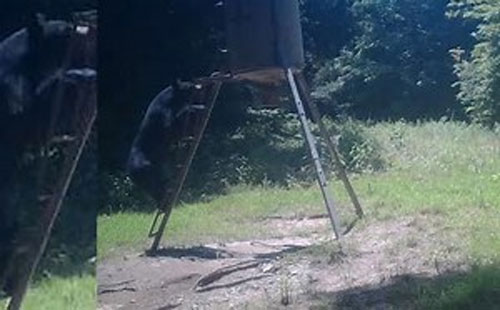Another black bear spotted in rural Sumner County

COTTONTOWN, Tenn. (WKRN) — For the second time in less than a month, a black bear has been spotted in Sumner County.
A trail camera in Cottontown picked up another one Monday afternoon near a family’s home. The Tennessee Wildlife Resources Agency verified with News 2 the new black bear’s presence along Bugg Hollow Road, which runs through both Cottontown and Gallatin.
The Sumner County Sheriff’s Office has been alerted as a precaution.
The sighting comes on the heels of a black bear sighting in the Bethpage-Gallatin area in late May. At that time, there had not been a black bear sighting reported in Sumner County for nearly a decade.
“Having bears popping up here in Middle Tennessee is somewhat of a conservation success story,” TWRA Public Relations Director Emily Buck said. “As the population grows in East Tennessee, they’re going to make their way more so across the state.”
Buck reminded the public that bears used to roam allof Tennessee. She said their arrival back into Middle Tennessee is a good sign with some of them possibly even coming from neighboring states.
“We make decisions based on the behavior the bear is showing,” Buck explained. “When young bears are leaving their mothers, they go on what I like to think of as a little adventure. They’re looking for their own range. That’s very natural bear behavior.”
“Is it ideal for a bear to live in a subdivision? No. Is it unnatural behavior for a bear to explore a subdivision, looking for a suitable habitat? Also, no,” Buck added.
Buck said the TWRA’s plan right now is to leave this new bear alone to find its way. Relocation, as many locals demanded before the first bear was hit and killed along a Gallatin highway, is statistically not effective, according to Buck.
“You just can’t take them back home to East Tennessee, because you’re just moving it away from where it wants to be,” Buck said.
Buck detailed a study conducted by the University of Tennessee that showed the dangers of relocating bears.
“Using GPS collars, we have been able to monitor what happens to those bears. Of the bears that were relocated in the study, 90% of them died within the first year.”
Buck added that bears being hit by cars is statistically more common after relocation, and far more common in East Tennessee, where bears remain more prominent.
There are lessons to be learned from what happened to the first bear. The top of that list, according to Buck, be respectful and give the bear some space.

